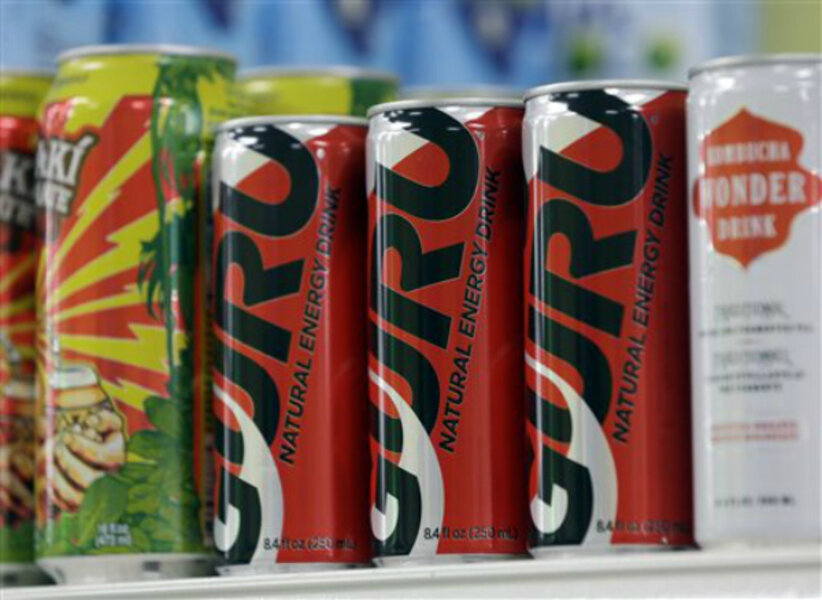Energy drinks, scrutinized for effects on kids, tout organic ingredients
Loading...
| Albany, NY
Energy drinks are busting out of the convenience store cooler and into the health food aisle.
As energy drink sales soar like a caffeine-fueled rocket, more drinks are promoting organic ingredients, added juices, natural caffeine and so-called "clean" energy. A jolt from Rockstar not your speed? There's the "natural energy drink" Guru, and Steaz Energy, which according to the can is "good for the mind, body and soul." Or there's Runa's energy drink, made from something called Amazonian guayusa leaves.
Claims of cleaner caffeine boosts come as energy drinks find themselves under increasing scrutiny, particularly for their effects on children and adolescents. The word "organic" in front of "energy drink" might seem as incompatible as yoga pants with a backward tractor cap, but analysts say that as the market for energy drinks grows, it's diversifying too.
"I think we're going to see more beverages that offer energy functionality, but in non-traditional energy drinks," says John Sicher, publisher of Beverage Digest.
Energy drink sales hit $12.6 billion last year, representing a 14 percent jump from 2008, according to market research firm Packaged Facts. While Red Bull, Monster and Rockstar still dominate the US market, part of the recent growth comes from new kinds of products, including diet and natural energy drinks. Even the big players are getting into the act. Campbell Soup Co.'s venerable V8 line of drinks now includes a canned V-Fusion + Energy drink made with juice and green tea. And Starbucks sells fruit-flavored Refreshers made with unroasted coffee beans.
"Because retailers are devoting more shelf space to energy drinks, there's always a battle among the competitors within the sector. So what you're seeing within the energy drink category is an innovation in products," says John Lennon, president of Xyience, which makes Xenergy energy drinks.
But with growth comes greater scrutiny.
Regulators have been increasingly concerned about caffeinated products, particularly energy drinks. The Food and Drug Administration in April said it would investigate the safety of caffeine added to snacks and gum and its effects on children and adolescents. The FDA said last year it was investigating reports of deaths linked to energy drinks. The federal agency has said they would take action if they could link the deaths to consumption of the drinks, including forcing the companies to take the products off the market.
And San Francisco's city attorney in May sued Monster Beverage for marketing its energy drinks to children. The lawsuit came after Monster sued City Attorney Dennis Herrera over his demands that the company reduce caffeine levels in its drinks and stop marketing to minors.
At least on face value, some of the natural drinks seem to be aiming for a different audience. Xenergy calls itself the "energy drink of the health club, not the nightclub." The company expanded its line this year to include energy drinks with tea or lemonade.
Ray Jolicoeur, vice-president marketing for Guru, says consumers of his product, which has been available in the United States since 2005, tend to be slightly more mature and educated. The entrepreneurs behind Runa say they are not looking for people who want "head throbbing, punched-in-the face energy" like some other brands.
Runa co-founder Dan MacCombie's energy drink hit the shelves recently around the country. It boasts its caffeine from the guayusa "super leaf" and supposedly provides as much caffeine as coffee with more anti-oxidants than green tea.
They join non-traditional energy drinks like Guru and Steaz, which share display space with the likes of aloe juice at Dean's Natural Foods in Albany. Owner Dean King said the drinks eliminate "ridiculous stuff" like artificial flavors and colors. The kick still comes from caffeine, but some consumers say it's different.
"You know how most caffeinated products you feel that surge come over you? And then you drop and you feel miserable? This is more of an alertness," says Cheryl Fairweather, a 36-year-old vegan and athlete from the Philadelphia area who drinks a daily can of Steaz at 4 a.m. before she trains.
"It doesn't have that overwhelming effect, like you're on edge," she says.
It's typical for the caffeine in natural energy drinks to come from organic and natural sources. But in the end, as Roland Griffiths, a professor of behavioral biology at Johns Hopkins University, notes, "caffeine is caffeine."
"It doesn't matter whether that compound is synthesized in a laboratory or is synthesized in a plant," he says. "It's going to have identical pharmacological, subjective and behavioral effects."
Guru says one 8.4-ounce can has 125 milligrams of "naturally occurring" caffeine. Steaz says a 12-ounce can of its energy drink contains 100 milligrams of caffeine from sustainably sourced ingredients. Ounce for ounce, that's in the ballpark of mainstream energy drinks, like Rockstar or Monster, which each deliver 160 milligrams of caffeine per 16-ounce can, according to the Center for Science in the Public Interest, a nutrition advocacy group.
The natural products generally do not make explicit health claims, opting instead to tout ingredients such as organic guarana or the lack of artificial colors. But Michael Jacobson, the executive director of the Center for Science in the Public Interest, says words like "natural" and "organic" printed on a can make consumers assume the contents are good for you, even if that's not necessarily so.
"It implies that there's something helpful about them and it's totally vague," he says.







